Unlocking the Secrets of the Small Wild Goose Pagoda: A Must-Visit in China
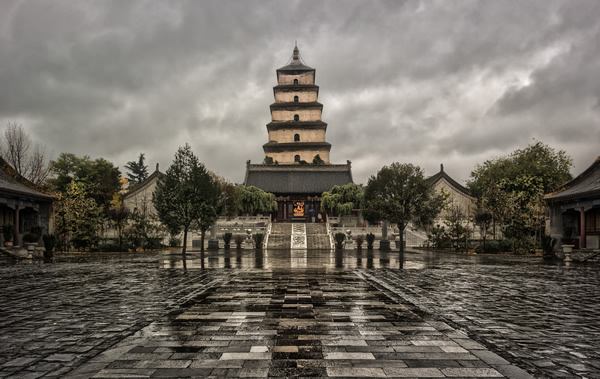
An Essential Guide to Visiting Small Wild Goose Pagoda
In This Guide
- An Essential Guide to Visiting Small Wild Goose Pagoda
- The Rich History and Legends of Small Wild Goose Pagoda
- Main Highlights: What You Absolutely Can’t Miss
- Planning Your Visit: A Practical Guide
- Tickets: Prices, Booking, and Tips
- How to Get There: A Complete Transportation Guide
- Local Cuisine and Accommodation Nearby
- Frequently Asked Questions
- Final Thoughts on Your Trip
Nestled within the serene Jianfu Temple grounds, the Small Wild Goose Pagoda stands as a testament to the profound history of Buddhism in China. Erected in 707 AD, this architectural marvel not only captures the essence of the Tang Dynasty but also offers visitors a chance to immerse themselves in the spiritual and cultural fabric of Xi’an. As you step into this tranquil oasis, the pagoda’s elegant silhouette, reminiscent of a bamboo shoot, greets you with a sense of reverence and wonder.
The pagoda itself, a UNESCO World Heritage site, was originally constructed to house the sacred Buddhist scriptures brought back by the esteemed monk Yi Jing after his travels to India. Over 1,300 years later, it continues to be a focal point for both locals and travelers alike, who come to admire its historical significance and architectural beauty. Surrounding the pagoda, the lush gardens and ancient sophora trees create a peaceful atmosphere, perfect for reflection or simply enjoying the moment.
Whether you are an avid history buff, a lover of architecture, or someone seeking spiritual solace, the Small Wild Goose Pagoda invites you to explore its storied past and appreciate the harmonious blend of nature and culture. Prepare to be enchanted as you delve into one of Xi’an’s most treasured landmarks, where history whispers through the centuries and the spirit of Buddhism continues to thrive.
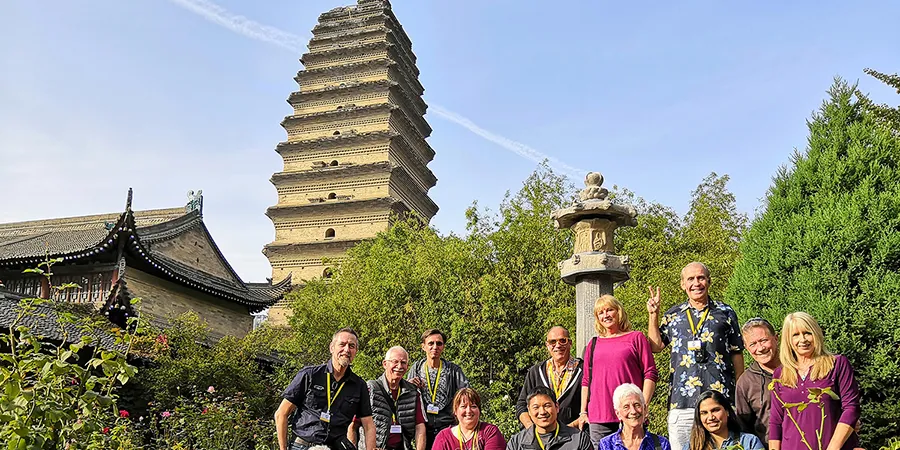
Small_Wild_Goose_Pagoda.
The Rich History and Legends of Small Wild Goose Pagoda
Nestled within the serene grounds of Jianfu Temple in Xi’an, the Small Wild Goose Pagoda stands as a testament to the rich tapestry of Chinese history and the profound influence of Buddhism in the region. Constructed in 707 AD during the Tang Dynasty, this architectural marvel not only serves as a religious monument but also encapsulates centuries of cultural significance and legends that continue to intrigue visitors today.
The Origins of the Pagoda
The story of the Small Wild Goose Pagoda begins with the esteemed monk Yi Jing, who returned to China from India, the cradle of Buddhism, armed with sacred scriptures and statues. Recognizing the need for a dedicated space to preserve these invaluable texts, Yi Jing sought the support of the imperial court. However, it was Emperor Li Xian’s wife, the Empress, who truly championed the cause. Upon hearing of Yi Jing’s request, she convened all the imperial concubines and court maids, urging them to contribute to the construction of this sacred edifice. Their generous donations exceeded expectations, allowing the pagoda to rise majestically—its completion marked a significant moment in the history of Buddhism in China.
Architectural Marvel
The Small Wild Goose Pagoda, with its distinct square design and bluish-grey brick facade, was originally 45 meters (148 feet) tall with 15 stories. Although a devastating earthquake in 1556 reduced its height to approximately 43.4 meters (142 feet) and eliminated two of its upper stories, the pagoda’s elegant structure remains intact. Its multiple eaves and slightly curved lines evoke the image of an emerging bamboo shoot, symbolizing resilience and growth. The pagoda is often referred to as the “sister building” to the more famous Giant Wild Goose Pagoda, which was constructed 55 years earlier. This connection highlights the shared purpose of both structures: to house and protect sacred Buddhist scriptures.
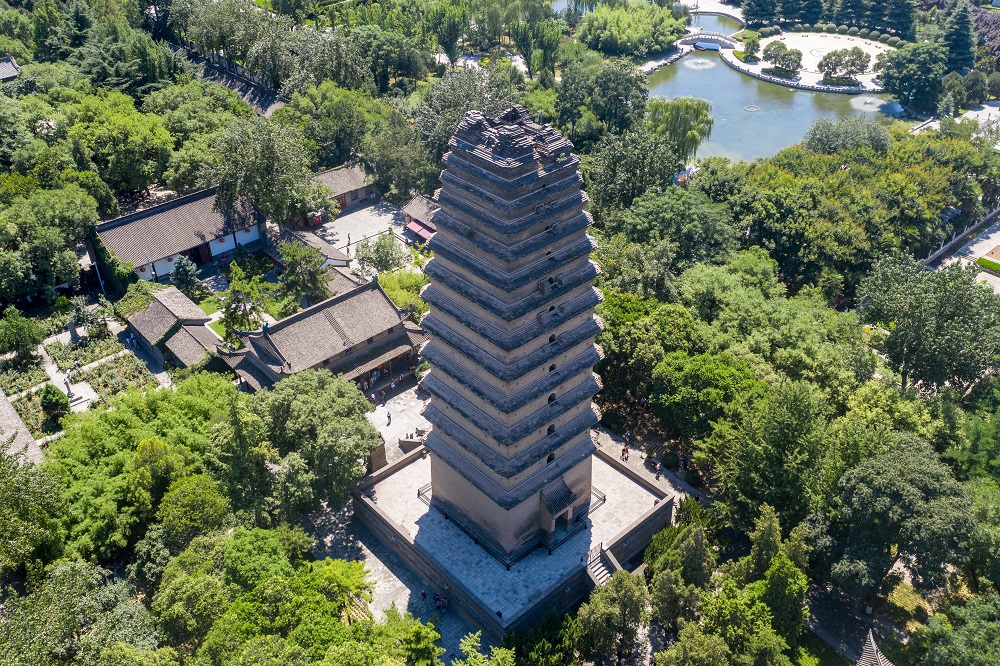
Small_Wild_Goose_Pagoda.
Legends Surrounding the Pagoda
Throughout its long history, the Small Wild Goose Pagoda has become entwined with various legends that reflect the spiritual beliefs and cultural practices of the time. One captivating tale involves the enormous iron bell housed within Jianfu Temple, dating back to the Jin Dynasty. Locals affectionately call it the “Magic Bell.” It is said that those longing for loved ones far away could write their names and addresses on yellow paper, and the sound of the bell would carry their message across the distance. Today, visitors can still ring this bell, making a wish and joining in the age-old tradition.
A Center for Cultural Exchange
The Small Wild Goose Pagoda not only symbolizes the spread of Buddhism in China but also serves as a historical crossroads where cultural exchange flourished. The Tang Dynasty was a period marked by openness and interaction with foreign cultures, particularly through the Silk Road. This pagoda stood as a beacon of knowledge, housing texts that would influence Chinese philosophy, art, and religion, thus integrating foreign elements into the local culture.
Experiencing the Legacy
Visiting the Small Wild Goose Pagoda today offers more than just a glimpse into ancient architecture; it provides a serene atmosphere steeped in history. Surrounded by ancient trees—planted during the pagoda’s construction—and the tranquil gardens of Jianfu Temple, visitors can immerse themselves in the cultural vibrancy of Xi’an. Morning exercises by local citizens, the resonant tones of the “Magic Bell,” and the exquisite relics in the nearby Xi’an Museum create a rich tapestry of experiences that connect the past with the present.
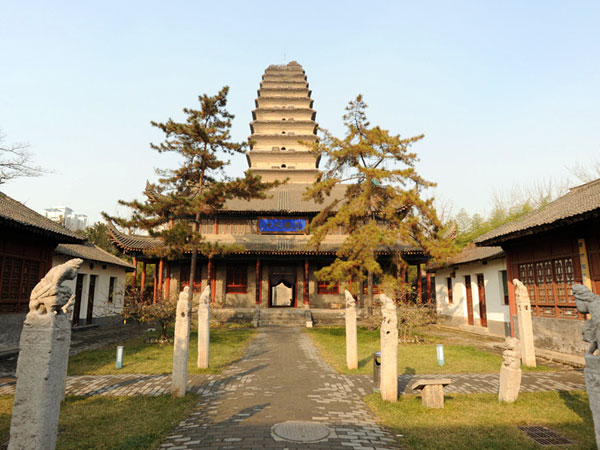
Small_Wild_Goose_Pagoda.
Conclusion
The Small Wild Goose Pagoda stands as a profound symbol of Xi’an’s historical legacy, embodying the spiritual devotion of its creators and the cultural exchanges that have shaped Chinese civilization. As you wander through its ancient grounds, you not only witness a piece of architectural beauty but also partake in the stories and legends that have endured through the ages, enriching your journey through China’s illustrious past.
Main Highlights: What You Absolutely Can’t Miss
Visiting the Small Wild Goose Pagoda in Xi’an is a journey through time, where ancient architecture meets serene spirituality. Nestled within the beautiful Jianfu Temple and adjacent to the Xi’an Museum, this architectural gem offers a wealth of history and culture. Here are the main highlights that you absolutely cannot miss during your visit.
A Glimpse into History: The Pagoda
-
An Ancient Marvel: Built in 707 AD, the Small Wild Goose Pagoda is over 1,300 years old and stands as a testament to the Tang Dynasty’s architectural prowess. Originally constructed to house the Buddhist scriptures brought back by the monk Yi Jing from India, the pagoda’s historical significance is palpable as you stand before its ancient walls.
-
Architectural Design: The pagoda reaches a height of 45 meters (148 feet) with 15 stories—though it currently stands at 43.4 meters due to damage from an earthquake in 1556. Its unique square shape and multiple eaves give it the appearance of a bamboo shoot, symbolizing growth and resilience.

Small_Wild_Goose_Pagoda.
Serene Surroundings: Jianfu Temple
-
A Peaceful Retreat: The pagoda is part of the tranquil Jianfu Temple, where visitors can immerse themselves in a serene atmosphere filled with the scent of incense and the sound of soft prayers. The temple grounds are adorned with ancient trees, some over a millennium old, adding to the site’s tranquil charm.
-
Morning Bell Chimes: Don’t miss the opportunity to ring the huge iron bell located within the temple. Dating back to 1192 AD, this bell is known for its crisp, resonant tone that can carry for miles. Legend has it that ringing the bell can send messages to loved ones far away—an enchanting experience for visitors.
Cultural Riches: Xi’an Museum
- Adjacent Museum: Located next to the pagoda, the Xi’an Museum is a treasure trove of cultural relics. It showcases exquisite artifacts from various dynasties, providing deeper insight into the rich tapestry of Chinese history. A visit here complements the experience of the pagoda, enriching your understanding of the era in which it was built.
Engaging with Local Life
- Morning Exercises: Visit the temple in the early morning to witness local residents engaging in tai chi and other exercises. This lively scene reflects the community spirit and offers a glimpse into the daily lives of the locals, inviting you to join in their routines.
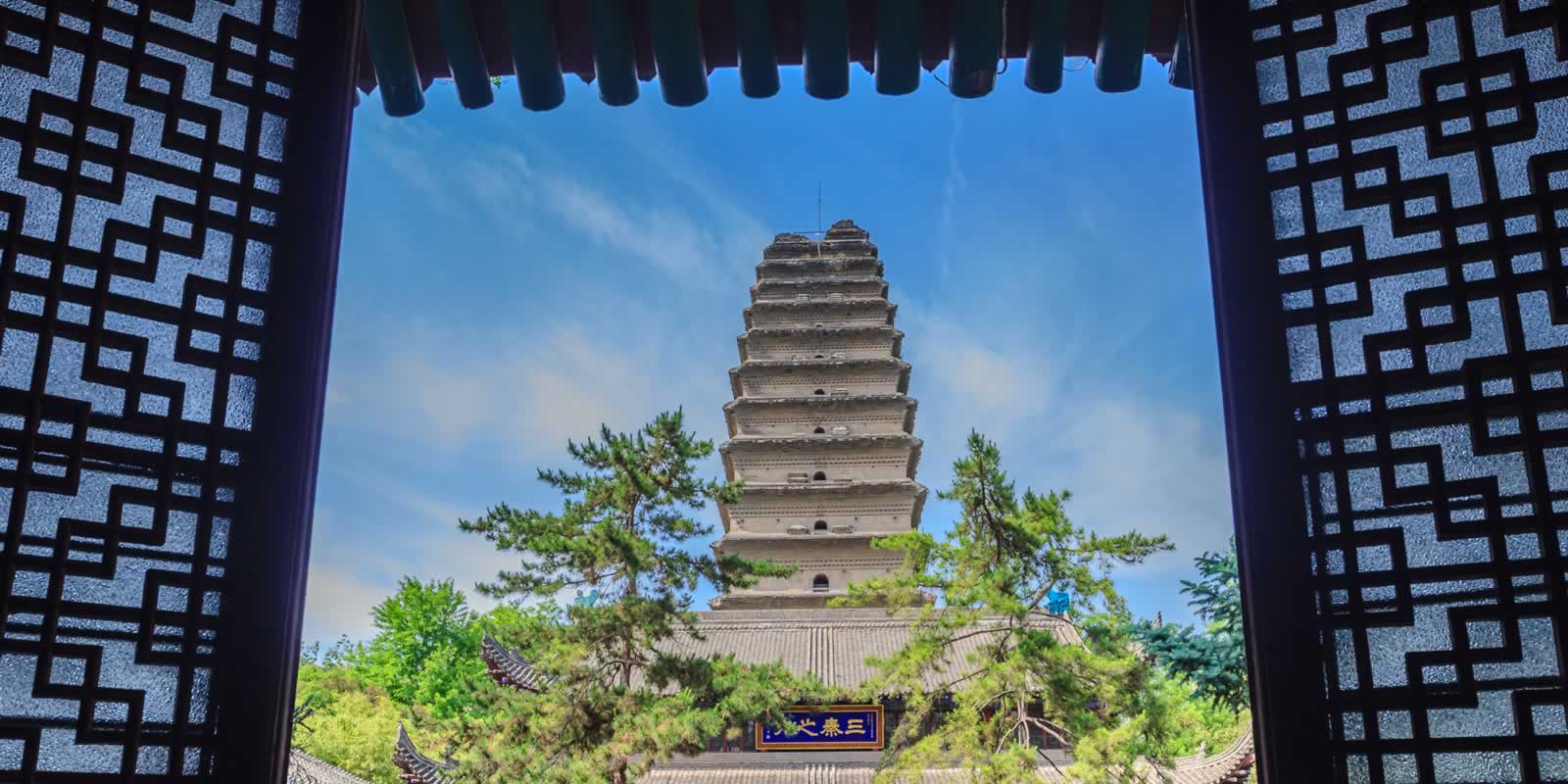
Small_Wild_Goose_Pagoda.
Ideal Visiting Tips
-
Best Time to Visit: For a truly picturesque experience, plan your visit in late autumn when the ginkgo trees turn golden and the maple leaves blaze red. Early morning (8:30–9:30 AM) or late afternoon (3:30–4 PM) are the best times to enjoy the site free from crowds.
-
Reservations Recommended: To ensure a smooth visit, particularly during peak seasons, it’s advisable to make a reservation through the pagoda’s official WeChat account, usually available up to six days in advance.
The Essence of the Experience
Visiting the Small Wild Goose Pagoda is not just about witnessing an ancient structure, but about immersing yourself in the tranquility and history it embodies. From the architectural beauty of the pagoda to the cultural insights offered by the Xi’an Museum, every moment spent here is an opportunity to connect with the rich heritage of China. Take your time to explore, reflect, and appreciate the wonders of this remarkable site.
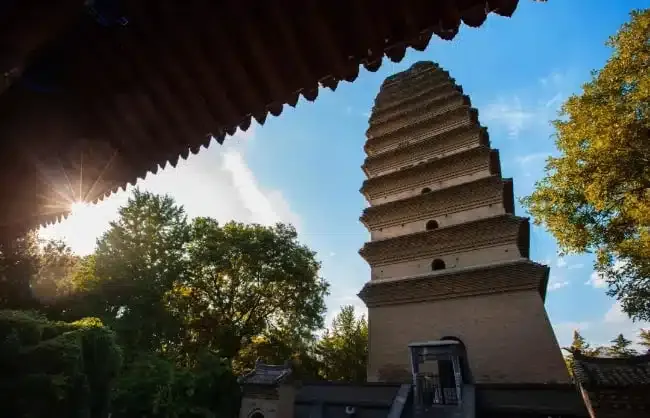
Small_Wild_Goose_Pagoda.
Planning Your Visit: A Practical Guide
Exploring the Small Wild Goose Pagoda: A Practical Visitor’s Guide
Nestled within the serene grounds of Jianfu Temple, the Small Wild Goose Pagoda (小雁塔) is a remarkable testament to Xi’an’s rich Buddhist heritage and architectural prowess. Whether you’re a history enthusiast or simply seeking a moment of tranquility, this pagoda offers an experience that is both enlightening and picturesque. Here’s everything you need to know for a fulfilling visit.
Basic Information
- Location: 72 West Friendship Road, Beilin District, Xi’an
- Opening Hours: Daily from 8:00 AM to 5:00 PM
- Entry Fee: Free
- Reservation: Recommended via the official WeChat account; reservations can be made up to 6 days in advance.
- Height: Originally 45 meters (148 feet) tall, now approximately 43.4 meters (142 feet) after an earthquake in 1556.
- Recommended Visit Duration: 1.5 to 2 hours
Getting There
- By Subway: Take Line 2 and alight at Nan Shao Men Station. Exit from Exit F and walk approximately 700 meters to reach the pagoda.
- By Taxi: While taxis are available, they can be hard to hail during peak hours. A private car is recommended for convenience.

Small_Wild_Goose_Pagoda.
Best Time to Visit
For a truly captivating experience, visit during late autumn (mid-November) when the maple and ginkgo trees transform the landscape into a tapestry of red and yellow. Morning visits (8:30 AM – 9:30 AM) or late afternoons (3:30 PM – 4:00 PM) are ideal, allowing you to witness locals practicing tai chi and other exercises, adding to the cultural richness of your visit.
What to See
-
The Pagoda Itself:
Marvel at the 13-story structure, showcasing the elegance of Tang Dynasty architecture. The pagoda’s unique design resembles an emerging bamboo shoot, symbolizing vitality and growth. -
Jianfu Temple:
Explore the temple complex surrounding the pagoda, including the impressive iron bell from the Jin Dynasty (1192 AD). Locals often refer to it as the “Magic Bell,” believed to carry messages to loved ones when rung. -
Xi’an Museum:
Adjacent to the pagoda, this museum houses a wealth of cultural relics from various dynasties. It’s an excellent opportunity to delve deeper into the history and art of ancient China. -
Ancient Trees:
Don’t miss the three ancient sophora trees that have stood guard since the pagoda’s construction, now protected as historical treasures.
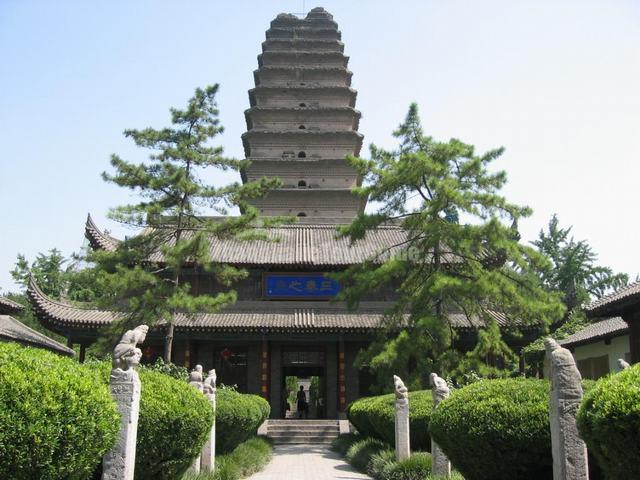
Small_Wild_Goose_Pagoda.
Photography Tips
For the best photographs, visit the courtyard beside the Great Buddha Hall. The interplay of light filtering through the ancient trees creates a stunning backdrop for capturing the essence of the pagoda and its surroundings.
Local Culture and Activities
While visiting, take a moment to engage with the local community. Early mornings often see residents participating in group exercises, offering a vibrant snapshot of daily life in Xi’an. You might be invited to join in, providing a unique cultural experience.
Nearby Attractions
- Anren Fang Ruins Exhibition Hall: Located just a short walk from the pagoda, this exhibition presents an immersive experience of Tang Dynasty culture through art and technology.
- Teahouse: After an enriching day of exploration, unwind at the teahouse within the temple grounds for a refreshing cup of traditional Chinese tea.
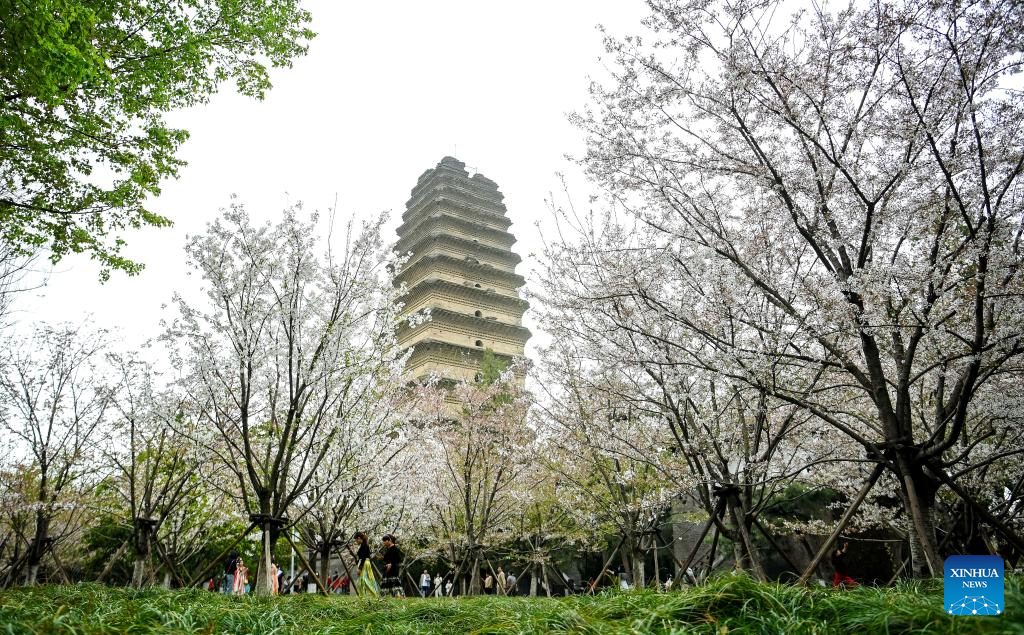
Small_Wild_Goose_Pagoda.
Final Thoughts
The Small Wild Goose Pagoda is not merely a historical site but a living part of Xi’an’s cultural fabric. With its tranquil atmosphere, stunning architecture, and proximity to significant cultural relics, it promises an enriching experience for any traveler. Take your time to soak in the serene surroundings and history, and allow yourself to be transported back to the Tang Dynasty, where Buddhism flourished and left an indelible mark on Chinese culture. Enjoy your visit!
Tickets: Prices, Booking, and Tips
When planning your visit to the Small Wild Goose Pagoda in Xi’an, you’ll be pleased to know that experiencing this historical gem is both accessible and budget-friendly. Here’s everything you need to know about tickets, booking, and some handy tips to enhance your visit.
Admission Information
-
Ticket Price: Free. Yes, you read that correctly! Entry to the Small Wild Goose Pagoda is complimentary, allowing you to immerse yourself in its serene environment without spending a dime.
-
Opening Hours: The site is open daily from 8 AM to 5 PM. It’s advisable to arrive early to enjoy a more tranquil atmosphere, especially if you wish to partake in morning exercises alongside local residents.
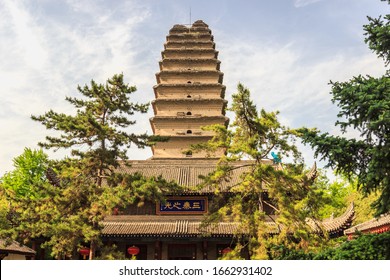
Small_Wild_Goose_Pagoda.
Reservation Details
-
Reservation Required: While entrance is free, reservations are necessary to manage visitor flow. You can secure your spot via the official WeChat account of the Small Wild Goose Pagoda.
-
Advance Booking: Reservations can typically be made up to 6 days in advance. This is particularly useful during peak tourist seasons or weekends when visitor numbers can swell.
Recommended Visit Duration
Plan to spend about 1.5 to 2 hours exploring the area. This timeframe allows you to appreciate the pagoda, visit the adjacent Jianfu Temple, and take a stroll through the Xi’an Museum, which showcases exquisite cultural relics from various Chinese dynasties.
Tips for a Great Experience
-
Best Times to Visit: For optimal ambiance, consider visiting in the morning (8:30–9:30 AM) or late afternoon (3:30–4 PM). During these times, you can witness the gentle morning exercises of locals or enjoy the beautiful golden hour lighting.
-
Photography Opportunities: The pagoda and its surroundings are particularly picturesque. For the best shots, head to the courtyard beside the Great Buddha Hall, where the interplay of light and ancient trees creates stunning visuals.
-
Explore Nearby Attractions: After touring the pagoda, take the opportunity to visit the nearby Xi’an Museum and the Anren Fang Ruins Exhibition Hall. Both offer fascinating insights into the region’s rich historical tapestry.
-
Stay Hydrated: There is a teahouse within the grounds where you can take a break and enjoy a cup of tea, especially if you find yourself needing a moment to recharge during your exploration.

Small_Wild_Goose_Pagoda.
Getting There
The Small Wild Goose Pagoda is conveniently located in the Beilin District of Xi’an, about 1 kilometer (0.6 miles) south of the downtown area. If you’re using public transport, the Nan Shao Men Station on Line 2 is the closest subway stop, approximately 700 meters from the pagoda.
With its rich history and stunning architecture, the Small Wild Goose Pagoda is a must-visit destination for anyone interested in Chinese culture and history. Enjoy your journey through time as you explore this remarkable site!

Small_Wild_Goose_Pagoda.
How to Get There: A Complete Transportation Guide
Navigating Your Way to the Small Wild Goose Pagoda
Visiting the Small Wild Goose Pagoda, a serene testament to ancient Chinese architecture, is a must for any traveler seeking to immerse themselves in Xi’an’s rich cultural heritage. Located within Jianfu Temple, just 1 kilometer (0.6 miles) south of Xi’an’s bustling downtown, this historical landmark is easily accessible via various modes of transportation. Below, you’ll find a comprehensive guide to getting there seamlessly.
By Subway
The Xi’an Metro is a convenient and efficient way to reach the Small Wild Goose Pagoda.
- Line: Take Line 2.
- Stop: Nan Shao Men Station.
- Exit: Head out from Exit F.
- Distance: The pagoda is approximately 700 meters (about 0.4 miles) from the station. A leisurely 10-minute walk will take you through the charming streets of Xi’an.
By Bus
For those who prefer local buses, Xi’an offers a range of routes that can bring you close to your destination.
- Bus Routes: Look for buses 18, 27, 31, 32, 52, or 71.
- Stop: Alight at Jianfu Temple Stop.
- Walking Distance: The pagoda is right at the temple complex, making it an easy stroll from the bus stop.
By Taxi or Ride-Hailing Services
Taxis are widely available in Xi’an, but be mindful of peak hours when traffic can be heavy.
- Taxi: Hailing a taxi is straightforward, though it may take longer during rush hour. Ensure the driver knows you wish to go to Jianfu Temple or Small Wild Goose Pagoda.
- Ride-Hailing Apps: Services like Didi are popular and can be a comfortable alternative. Simply input your destination for a hassle-free ride.
By Private Car
For travelers who enjoy the freedom of driving, renting a car can be a viable option.
- Parking: There is parking available near the Jianfu Temple, but be prepared for potential crowds, especially during weekends and holidays.
Additional Tips for Your Journey
- Reservation: Although entrance to the Small Wild Goose Pagoda is free, it is recommended to make a reservation through its official WeChat account, allowing you to avoid any last-minute hassle.
- Best Time to Visit: Early mornings or late afternoons are ideal for visiting, not just for the cooler temperatures but also for the opportunity to witness locals engaging in traditional morning exercises in the gardens.
- Photography: For those interested in capturing the perfect shot, the courtyard beside the Great Buddha Hall offers stunning views of the pagoda, especially when the sun filters through the ancient trees.
With these transportation options at your disposal, getting to the Small Wild Goose Pagoda will be a straightforward and enjoyable part of your historical exploration in Xi’an. Prepare to be captivated by the serene beauty and rich heritage that this ancient structure has to offer!
Local Cuisine and Accommodation Nearby
Exploring the area around the Small Wild Goose Pagoda is a delightful experience not only for history enthusiasts but also for food lovers and those seeking comfortable accommodations. Here’s a guide to some local culinary delights and nearby places to stay that will enhance your visit to this ancient landmark.
Culinary Delights in the Vicinity
- Qin Chuan Restaurant (秦川饭店)
- Cuisine: Traditional Shaanxi Cuisine
- Highlights: Famous for its biangbiang noodles, a signature dish characterized by its wide, hand-pulled noodles served with spicy sauce and various toppings. Don’t miss trying the yangrou paomo (lamb soup with bread) for a truly local experience.
-
Location: Approximately 1.2 kilometers from the pagoda, making it a convenient spot for lunch after your visit.
-
Dumpling Banquet at De Fa Chang (德发长)
- Cuisine: Dumplings
- Highlights: This renowned restaurant specializes in dumpling banquets, offering a delightful array of dumplings with different fillings, served in various steaming methods. The pomegranate-flavored dumplings are a must-try, representing the local flavor.
-
Location: Located about 2 kilometers from the Small Wild Goose Pagoda, it’s best to reserve a table in advance due to its popularity.
-
Muslim Quarter Street Food (回民街)
- Cuisine: Diverse Street Food
- Highlights: A vibrant street market offering a variety of snacks such as roujiamo (Chinese hamburger), yangrou chuan (lamb skewers), and sweet pomegranate juice. The atmosphere is bustling, making it a great place to soak in local culture while sampling delicious bites.
- Location: About 3 kilometers away, this is perfect for an evening stroll and a taste of local life after visiting the pagoda.
Comfortable Accommodations Nearby
- Sofitel Legend People’s Grand Hotel Xi’an
- Description: This luxurious hotel blends modern amenities with traditional Chinese architecture. With its opulent rooms and excellent service, it’s an ideal choice for those seeking comfort and elegance.
-
Distance: Approximately 3 kilometers from the Small Wild Goose Pagoda, it provides convenient access to both historical sites and city attractions.
-
Hanting Hotel Xi’an South Gate
- Description: A budget-friendly option that offers clean and comfortable rooms. It’s a great base for travelers wanting to explore the city without breaking the bank.
-
Distance: Located about 1.5 kilometers from the pagoda, it’s within walking distance of public transport and local eateries.
-
Xi’an Eastern House Hotel
- Description: This stylish boutique hotel combines contemporary design with traditional Chinese elements. It features spacious rooms, a lovely courtyard, and a restaurant serving local dishes.
- Distance: Roughly 2 kilometers from the Small Wild Goose Pagoda, making it a peaceful retreat after a day of sightseeing.
Final Thoughts
Visiting the Small Wild Goose Pagoda offers a unique glimpse into China’s rich history and cultural heritage. By indulging in local cuisine and choosing comfortable accommodations nearby, you can enhance your travel experience, immersing yourself fully in the vibrant life of Xi’an. Whether it’s savoring the famous dumplings or enjoying an evening walk to the bustling Muslim Quarter, the area around the pagoda has much to offer to the discerning traveler.
Frequently Asked Questions
Frequently Asked Questions about Small Wild Goose Pagoda
1. What are the opening hours of Small Wild Goose Pagoda?
The Small Wild Goose Pagoda is open from 8 AM to 5 PM daily. It’s advisable to visit during the morning or late afternoon for a more serene experience.
2. Is there an entry fee for visiting the pagoda?
Entry to the Small Wild Goose Pagoda is free of charge. However, it is recommended to make a reservation through its official WeChat account, usually available up to 6 days in advance.
3. How tall is the Small Wild Goose Pagoda?
The pagoda has 15 stories and stands approximately 45 meters (148 feet) tall; however, due to an earthquake in 1556, it currently reaches about 43.4 meters (142 feet).
4. What can I see at the Small Wild Goose Pagoda site?
The site includes three main attractions:
– The Small Wild Goose Pagoda itself, a historic architectural marvel.
– Jianfu Temple, home to a significant ancient bell known as the “Magic Bell”.
– Xi’an Museum, which showcases a wealth of cultural relics from various Chinese dynasties.
5. How do I get to the Small Wild Goose Pagoda?
You can reach the Small Wild Goose Pagoda by various means:
– Subway: Take Line 2 and exit at Nan Shao Men Station. From Exit F, it’s about 700 meters to walk.
– Taxi: While possible, it might be challenging during peak hours due to traffic.
– Private car: This is often the most convenient option.
6. What is the best time to visit the Small Wild Goose Pagoda?
The ideal time to visit is in late autumn, particularly in mid-November, when the leaves turn vibrant shades of red and yellow. Early mornings (8:30-9:30 AM) and late afternoons (3:30-4 PM) are also great for fewer crowds and cooler temperatures.
7. Can I enter the Small Wild Goose Pagoda?
Currently, tourists are not permitted to enter or climb the pagoda due to ongoing maintenance and reinforcement work. However, you can still admire its exterior and enjoy the surrounding gardens.
8. What activities can I do around the Small Wild Goose Pagoda?
Visitors can:
– Join locals in morning exercises such as tai chi and dance in the Jianfu Temple gardens.
– Explore the Xi’an Museum for a deeper understanding of the region’s history.
– Relax at the nearby teahouse for a refreshing break after sightseeing.
– Visit the Anren Fang Ruins Exhibition Hall to discover more about Tang Dynasty culture and daily life.
Feel free to reach out if you have more questions or need assistance planning your visit!
Final Thoughts on Your Trip
As you prepare to conclude your visit to the Small Wild Goose Pagoda, take a moment to reflect on the profound journey through history and culture that this site offers. Nestled within the tranquil grounds of Jianfu Temple and adjacent to the enlightening Xi’an Museum, the pagoda stands as a testament to the enduring legacy of Buddhism in China and the architectural brilliance of the Tang Dynasty.
A Journey Through Time
Standing before the ancient structure, which has withstood the test of time for over 1,300 years, you can almost hear the whispers of the past. It’s an extraordinary experience to witness firsthand how this pagoda has witnessed the ebb and flow of Chinese civilization, from the flourishing Tang Dynasty to the present day. The serene atmosphere invites reflection, while the rich historical context offers a deeper understanding of the cultural tapestry that defines Xi’an.
Immerse Yourself in Local Culture
Beyond the pagoda itself, the surrounding areas provide a glimpse into daily life in Xi’an. Whether you join locals in their morning tai chi routines, ring the ancient bell for blessings, or enjoy the exquisite relics at the museum, each moment spent here enriches your travel experience. The vibrant community atmosphere enhances the beauty of your visit, making it not just a stop on your itinerary, but a meaningful engagement with the heart of Chinese culture.
Capture the Essence of Xi’an
Before leaving, consider capturing the enchanting views of the pagoda framed by autumn foliage or the gentle light filtering through ancient trees. These memories, much like the pagoda itself, will remain long after your journey ends. Remember, your visit to the Small Wild Goose Pagoda is not merely about observing history; it’s about feeling it, absorbing the tranquility, and connecting with the stories that have shaped this remarkable city.
As you depart, carry with you the spirit of Xi’an—a city where history is alive, culture is cherished, and every street corner tells a story waiting to be discovered. Your adventure here is just the beginning; may it ignite a lifelong curiosity about the wonders of China and inspire future travels. Safe travels!